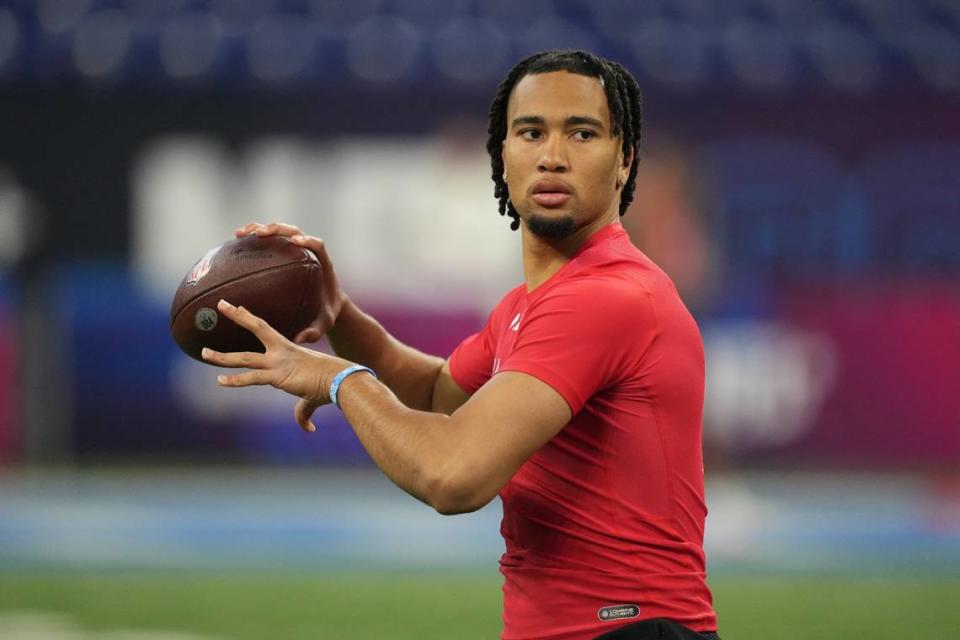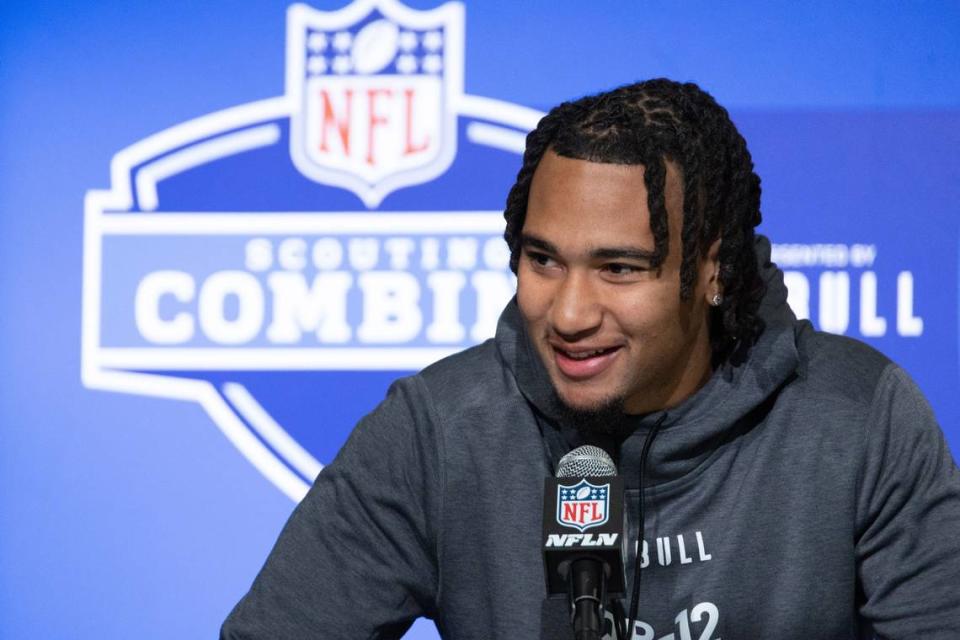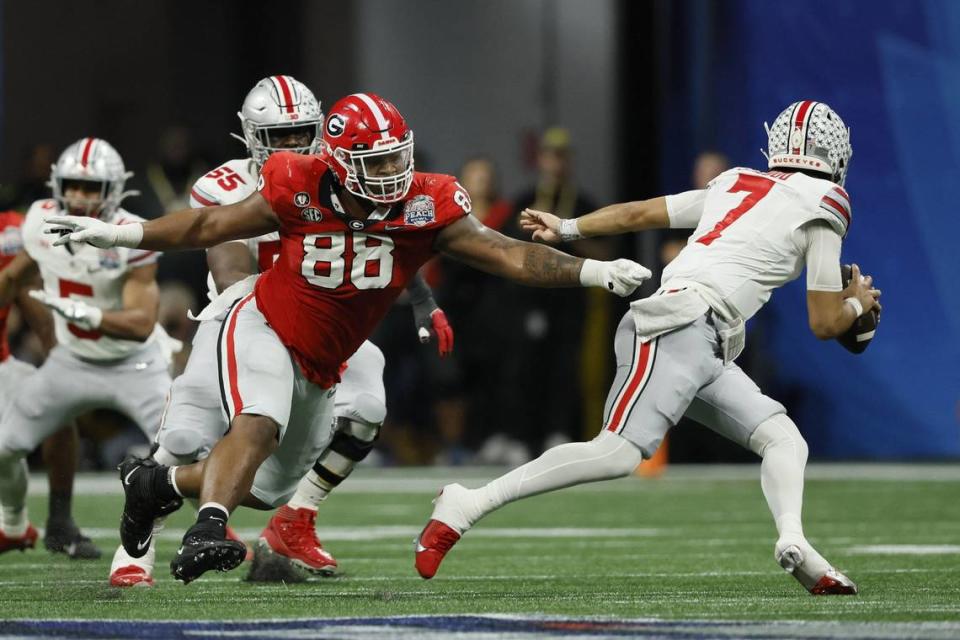Should Panthers draft CJ Stroud at No. 1 overall? Breaking down Ohio State QB’s game
- Oops!Something went wrong.Please try again later.
- Oops!Something went wrong.Please try again later.
- Oops!Something went wrong.Please try again later.
With the first pick in the 2023 NFL Draft, the Carolina Panthers will select one of four quarterbacks. Bryce Young (Alabama), C.J. Stroud (Ohio State) Anthony Richardson (Florida) and Will Levis (Kentucky) all have a case to be the top pick.
Over the next four weeks, The Observer is breaking down the top four quarterback prospects to analyze which of the four might be the best fit for the Panthers and new coach Frank Reich. We’ll unpack what each prospect does best, identify their ideal NFL scheme fits, and then project who they’ll become as professionals based on the shades of NFL quarterback play they already possess.
This process is based on film evaluations and conversations with scouts and evaluators around the league.
Let’s start with two-year Buckeyes standout C.J. Stroud.
What Stroud does best
Stroud looks like a prototypical quarterback in the mold of signal-callers from Reich’s past. He stands 6 feet 3 inches tall and weighs 215 pounds, aligning with players like Philip Rivers, Carson Wentz and Andrew Luck from Reich’s time in Indianapolis. As a thrower, there is not a pass Stroud cannot make. As one evaluator said: “He has every club in his bag.”
He’s a quick-game ace, able to thread slants, unders, stick routes, curls and hitches into tight windows. He’s smooth as a drop-back passer. His feet are tied to his arm and eyes. When Stroud hits the top of his drop, he either throws on time or quickly resets his feet if he feels pressure or interprets sticky downfield coverage.
Since he’s such an on-schedule thrower, Stroud passes with a sturdy base. He generates power by keeping his cleats in the ground, driving off his feet, through his hips and torso. Being on time takes anticipation. Often, young quarterbacks need to see their target open before throwing. Not Stroud. His game tape is littered with anticipation throws — deep or intermediate routes where the ball is out of his hand before the intended receiver is looking for the ball.
There aren’t signs of panicked or forced throws on his tape. He’s ready for every moment and raises his level of play in must-win games. Stroud electrified evaluators in a 42-41 Peach Bowl loss to Georgia by throwing for 341 yards and four touchdowns. His escapability and off-script playmaking forced scouts to rewrite their reports.
Against Georgia, his first two passing touchdowns were scramble drills he turned into scores. Twice in the first half he evaded the Bulldogs’ pass rush, kept his eyes downfield, reset and delivered 30-yard strikes into the end zone. Three of his four touchdown passes came outside the pocket.
Before the College Football Playoff semifinal, Stroud was considered a pure pocket passer. The redshirt sophomore garnered far more Jared Goff comparisons than Joe Burrow projections. Evaluators were split on his reluctance to escape the pocket or keep the ball on certain run-pass option plays. Stroud is athletic enough to create an off-schedule, he just did not want to, largely because he did not have to. The Buckeyes’ average margin of victory with Stroud was 23 points.
“He’s been disciplined and wants to prove himself as a pocket passer, which is fine. But at some point, you have to have the balance between being the pocket passer and being the guy who can make plays,” NFL.com draft analyst Lance Zierlein said. “If he doesn’t play with that type of pocket mobility and that type of play extending, and getting outside of the pocket and hurting people with his legs from time to time, then I think he does himself a disservice.”
Annually, Ohio State head coach Ryan Day surrounds his starting quarterbacks with five-star talent. Day made Stroud’s life easy in Columbus. But in the NFL, parity is king. Success in the NFL takes expert coaching and scheme combined with an internal enthusiasm for learning.
Ideal NFL scheme fit
Evaluators agree Stroud belongs in an open-concept offense grounded with rhythm and timing throws. He’s been described as a point guard — a savvy distributor who thrives at diagnosing defenses and exploiting advantageous matchups. Stroud thrived at Ohio State carving zone defenses and burning the few defensive backs who dared to play man-to-man.
“C.J. fits what Frank (Reich) has run in years past,” ESPN draft analyst Jordan Reid. “He needs to be in a rhythm-based offense just because he doesn’t have a super strong arm. He can get the ball vertically. But it’s not a Will Levis or Anthony Richardson type of arm. He has enough arm strength to attack the deeper proportions on the field. But he’s at his best when he can throw in that rhythm-based offense. He has to have some weapons around him, too.”
Reich is likely bringing those same West Coast philosophies to Carolina, a scheme that is reliant on talented playmakers to create after the catch. Since trading DJ Moore to the Bears as part of a blockbuster trade for the No. 1 pick, Carolina’s receiving talent is unproven at best. Moore accounted for 28% of Carolina’s receiving yards (888) last season. His seven touchdowns made up 44% of the team’s 16 total receiving touchdowns. Terrace Marshall Jr., Shi Smith and Laviska Shenault Jr. are the only receivers currently on the roster who caught a pass last season.
Carolina has added dynamic running back Miles Sanders and tight end Hayden Hurst through free agency. The team will likely sign a veteran wide receiver and draft multiple pass catchers in the draft. But trading Moore instantly shifted the Panthers’ offense from an ideal landing spot to an unknown commodity.
Shades of which NFL QB?
Stoud has shades of Kirk Cousins, Derek Carr and Dak Prescott in his game. The latter is his most comparable ceiling. He processes quickly at the line of scrimmage, he’s in complete command of his offense, accurately calls protections and knows exactly where the ball should go against any coverage.
But he operated in a nearly perfect system. Ohio State rosters better athletes than every team they played other than Georgia. During the regular season, he routinely faced clean pockets and threw to receivers with yards of separation. Ohio State receiver Marvin Harrison Jr. will likely be a top-three pick in the 2024 draft. The Buckeyes’ No. 2 receiver, Jaxon Smith-Njigba, should be a first-round draft selection this year. Stroud will throw to less talented receivers as a pro while facing elite defensive athletes every week.
He doesn’t have Patrick Mahomes, Burrow, Josh Allen, Justin Herbert, Trevor Lawrence or Lamar Jackson talent. But in a best-case scenario, he could evolve into the sixth-best quarterback in the NFL. Carolina landing a potential top-10 quarterback from an enigmatic quarterback class makes Stroud worth the No. 1 pick.



